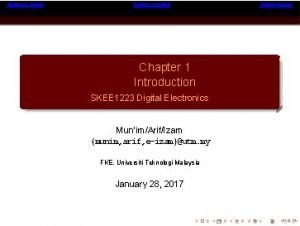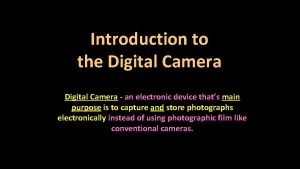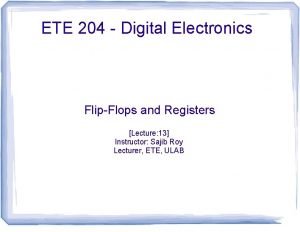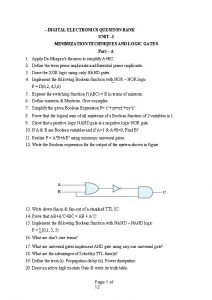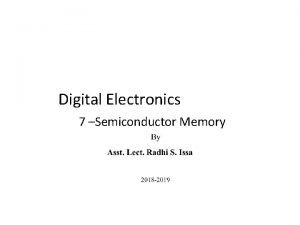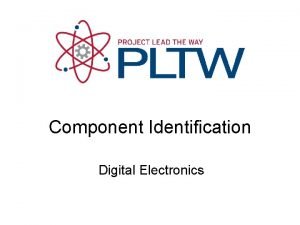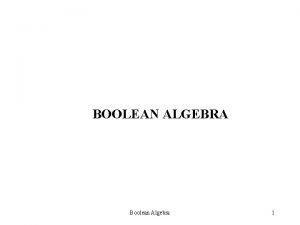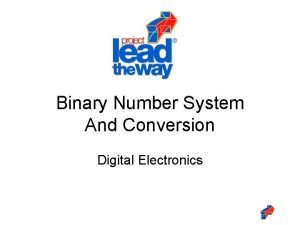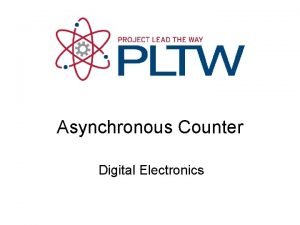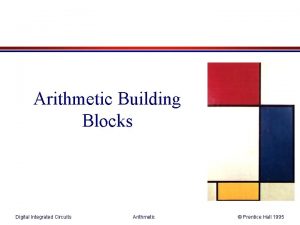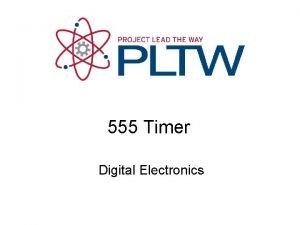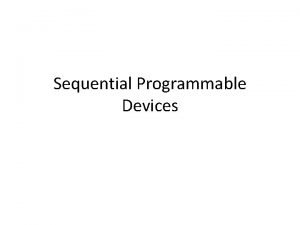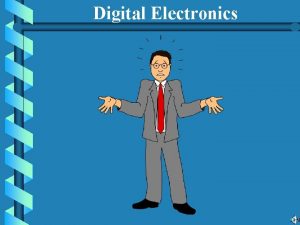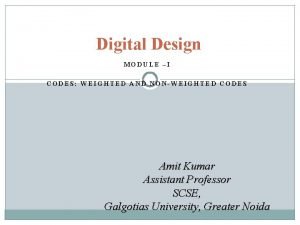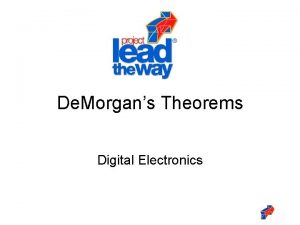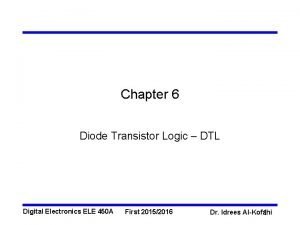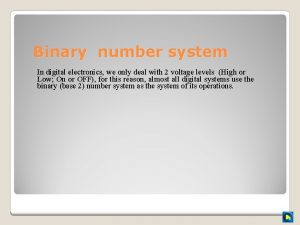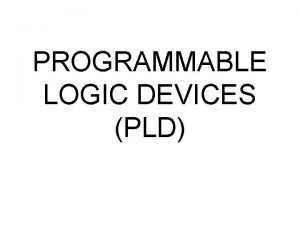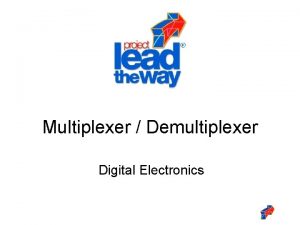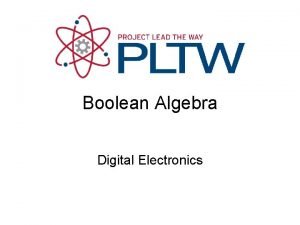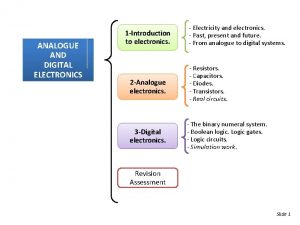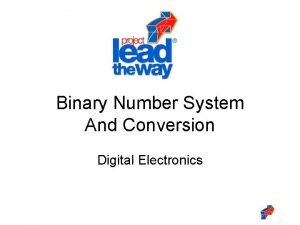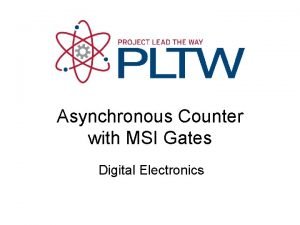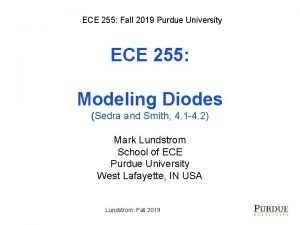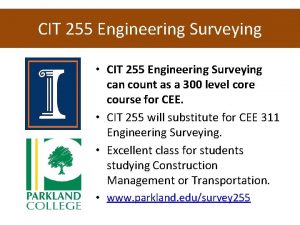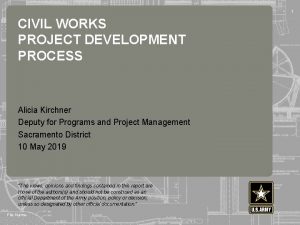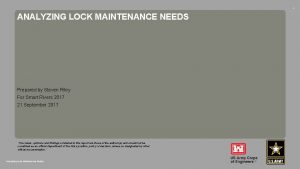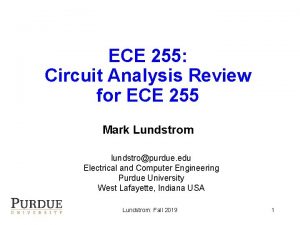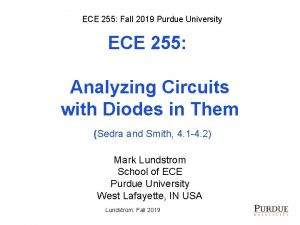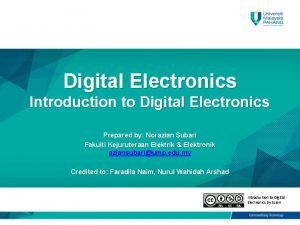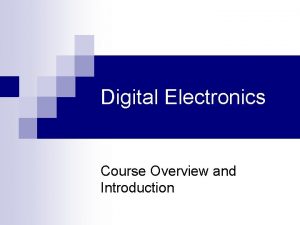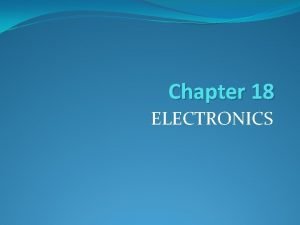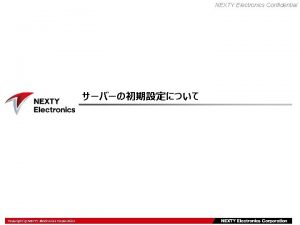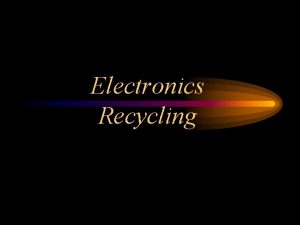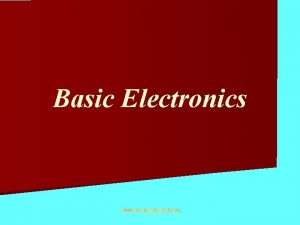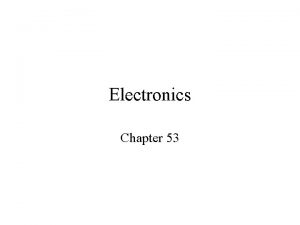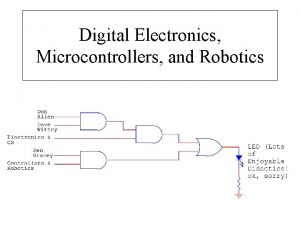Digital Electronics 1 ET 255 Introduction to Digital





























- Slides: 29

Digital Electronics 1 ET 255 Introduction to Digital Concepts Chapter 1

Digital and Analog Quantities • Analog quantity is any value that, when measured, changes over a period of time – It encompasses an infinite number of values over time – No measure is to small to be included – Gradual changes – Example: A sinusoidal wave • Digital quantity are discrete values represented over time – A precise value is represented at a given moment of time – All values in between those steps in time are ignored

Digital and Analog Quantities • Digital has the advantage over Analog – it is easier to transmit and decode a digital signal than an Analog one – Noise has less impact on a digital signal – Requires less power to transmit digital than Analog

Binary Digit - Bit • A binary digit or bit is the smallest unit of logic that a digital system recognizes – 0 = low logic, 0 V, Off, False – 1 = High logic, 5 V, On, True • Digital interchanges these expressions as it sees fit • Logic levels that constitute a logic state in digital fall within these ranges: Between L – VL(Min) – Typically Ground (OV) – VL(Max) – Amt of max voltage to be at a logic 0 MAX and LMIN is logic 0 Voltage in between VHMIN and VLMAX is forbidden by logic – VH(Min) – Amt of min voltage to be at a logic 1 – VH(Max) – Typically VCC or VDD Between HMIN and HMAX is a logic 1

Binary Digit • The Digital Waveform and its rising and falling edges – Rising Edge: – 0 V to 5 V transition of a digital pulse – Falling Edge: – 5 V to 0 V transition of a digital pulse – Rise Time: TR – Amt. of time it takes to go from 10% voltage to 90% voltage – Fall Time: TF - Amt. of time it takes to go from 90% voltage to 10% voltage – Pulse Width: TW – Length of pulse measure from its 50% voltage points – Period: Amt. of time it takes for a signal to repeat its cycle (T) – Frequency: Amt. of cycles that get repeated in a second (Hz) – Duty Cycle: % of the waveform that is “on” or active in logic [ TON / T]100 • Square: 50% Duty Cycle. Half on and half off • Rectangular: < or > than 50% Duty Cycle – Clock: is any repeating series of digital pulses that follow a 0 V to 5 V to 0 V transition in TTL logic – Timing Diagram is: a diagram that represents a series of logic levels over a period of time. Represent either inputs or outputs.

Data Transfer • Two main types of data transfer are serial and parallel – Serial implies only 1 bit is being sent or received per clock pulse • Bits are lined up one after the other down a single conductor • Example: 011010000010111001010001 • 32 bits over a single conductor. Take 32 clock pulses to send all the data – Parallel implies multiple bits are being sent simultaneously over multiple conductors • Bits would be organized in 4 groups of 8 and sent 1 group per clock pulse • Same 32 bits would take 4 clock pulses over 8 conductors

Logic Gates • Logic gates are IC’s (Integrated Circuits) that follow the rules and laws of Boolean Algebra – Main logic gates are: AND, OR, NOT, Ex-OR – Sub gates include: NAND, NOR, Ex-NOR • The following slides will break down the gates, their TTL family number, Truth Table, and pin layout • IT IS IMPORTANT to learn these gates. All of digital is tied to the logical theory of these chips

Logic Gates - AND • AND – Boolean Algebra equivalent to Multiplication • TTL designation: 7408 -2 input, 7411 -3 input Output • Truth Table: Inputs: 7411 Inputs Output 7408 0 0 1 1 1 0 0 1 1 0 1 0 1 0 0 0 0 1

Logic Gate - AND • PIN LAYOUT for 7408 and 7411 1 A 1 B 1 Y 2 A 2 B 2 Y Gnd 1 14 2 13 3 4 5 6 7 7 4 12 0 11 8 10 Vcc 1 A 4 A 1 B 4 B 2 A 4 Y 2 B 3 A 3 B 14 2 13 3 4 2 C 2 Y 9 8 1 5 6 3 Y Gnd 7 7 4 12 1 11 1 10 9 8 Vcc 1 C 1 Y 3 C 3 B 3 A 3 Y

Logic Gate - OR • OR – Boolean Algebra equivalent to Addition • TTL Designation: 7432 - 2 input • Truth Table Input: 7432 Output 0 0 1 1 1 0 1 1 • Any 1 logic in, produce a 1 logic out

Logic Gate - OR • Pin Layout for the 7432 is IDENTICAL to Vcc the 7408 pin layout 1 A 1 B 1 Y 2 A 2 B 2 Y Gnd 1 14 2 13 3 7 4 12 4 3 11 5 2 10 6 7 4 A 4 B 4 Y 3 A 3 B 9 8 3 Y

Logic Gate – NOT “inverter” • • NOT – Boolean Algebra implies inverse logic NOT Gate or Inverter is a single input Gate TTL Designation: 7404 Truth Table: Input Output 7404 0 1 1 0 • Denotes logic with an apostrophe or overbar

Logic Gate - NOT • Pin Layout for 7404 NOT Gate 1 A 1 Y 2 A 2 Y 3 A 3 Y Gnd 1 14 2 13 3 7 4 12 4 0 11 5 4 10 6 7 Vcc 6 A 6 Y 5 A 5 Y 4 A 9 8 4 Y

Logic Gate – Ex-OR • • • Exclusive OR – Specialized Logic Gate Identical logic on all inputs produce a 0 logic out Different logic on all inputs produce a 1 logic out TTL Designation: 7486 Truth Table: Input: 7486 Output 0 0 1 1 1 0

Logic Gate – Ex-OR • Pin Layout for 7486 Ex-OR Gate 1 A 1 B 1 Y 2 A 2 B 2 Y Gnd 1 14 2 13 3 7 4 12 4 8 11 5 6 10 6 7 Vcc 4 A 4 B 4 Y 3 A 3 B 9 8 3 Y

Logic Gate - NAND • NAND is comprised of a 7408 AND and a 7404 NOT Gate NOT AND = NAND • NAND has the inverse Boolean Logic as AND • TTL Designation: 7400 - 2 input, 7410 - 3 input Output Inputs: 7410 • Truth Table: Inputs Output 7400 0 0 1 1 1 0 0 0 1 1 0 1 0 1 1 1 1 1 0

Logic Gate - NAND • Pin Layout for 7400 2 input NAND Gate 1 A 1 B 1 Y 2 A 2 B 2 Y Gnd 1 14 2 13 3 7 4 12 4 0 11 5 0 10 6 7 Vcc 4 A 4 B 4 Y 3 A 3 B 9 8 3 Y

Logic Gate - NOR • NOR is comprised of a 7432 OR Gate and a 7404 NOT Gate NOT OR = NOR • NOR has the inverse Boolean Logic of OR • TTL Designation: 7402 - 2 input • Truth Table: Input: 7402 Output 0 0 1 0 1 0 0 1 1 0

Logic Gate - NOR • Pin Layout for 7402 2 input NOR Gate 1 Y 1 A 1 B 2 Y 2 A 2 B Gnd 1 14 2 13 3 7 4 12 4 0 11 5 2 10 6 7 Vcc 4 Y 4 B 4 A 3 Y 3 B 9 8 3 A

Logic Gate – Ex-Nor • • • Exclusive NOR – Specialized Logic Gate Identical logic on all inputs produce a 1 logic out Different logic on all inputs produce a 0 logic out TTL Designation: N/A (4000 series CMOS) Truth Table Input: 7486 Output 0 0 1 0 1 0 0 1 1 1

Digital Applications • Magnitude Comparators, Arithmetic, Code Conversion, Encoding, Decoding, Data Selection, Storage, and Counting – Magnitude Comparators: Compare two words and mathematically chooses if one is greater than, equal to, or less than the other – Arithmetic: Addition, Subtraction, Multiplication, and Division – Code Conversion: Allows for one binary code to be converted to another (Binary Gray) – Encoding / Decoding: allows for inputs to be altered to unique outputs and be reverted back to the original

Digital Applications – Data Selection: Allows for Multiplexed and Demultiplexed lines to be selected as an output or input – Storage: Registers and flip flops offer memory devices to hold a logical state – Counting: Utilizes Flip Flops to increment coded binary systems into a synchronized clocked event

IC Packages • DIP – Dual Inline Package • SMT – Surface Mount Technology – SOIC: small outline integrated circuit – PLCC: plastic leaded chip carrier – LCCC: leadless ceramic chip carrier – FP: flat pack – SSOP: shrink small outline package – TSSOP: thin shrink small outline package – TVSOP: thin very small outline package

IC Packages • Numbering of IC’s – Pin 1 is typically in the top left most part of an IC – The pins are then arranged and numbered in a counter-clock wise sequence going down, across, then back up – The notch represents the 1 14 top of the chip – To the left of the notch is always pin 1 2 13 – A dot may also be used to represent pin 1 7 3 12 4 3 2 1 20 19 4 18 4 11 0 5 17 6 16 7 15 8 14 9 10 11 12 13 5 2 10 6 9 7 8

IC Packages • Complexity Classifications for Fixed Function IC – SSI: Small Scale Integration – up to 12 equivalent gate circuits (logic gates) – MSI: Medium Scale Integration – from 12 to 99 equivalent gates on a chip (encoder, decoder, register) – LSI: Large Scale Integration – 100 to 9999 equivalent gates (memory) – VLSI: Very Large Scale Integration – 10, 000 to 99, 999 equivalent gates – ULSI: Ultra Large Scale Integration – 100, 000 gates or larger (CPU’s, High Capacity Memory)

Programmable Logic Devices • 3 major categories: SPLD, CPLD, and FPGA – SPLD: Simple Programmable Logic Devices • PROM – EPROM and EEPROM: Programmable Read Only Memory (Erasable and Electrically Erasable) • PAL: Programmable Array Logic • PLA: Programmable Array Logic • GAL: Gate Array Logic – CPLD: Complex Programmable Logic Devices • Macrocell • Programmable Interconnect • I/O Pads – FPGA: Field Programmable Gate Array

Test Equipment • Oscilloscope: Device that visually displays voltage or current over time • Logic Analyzer: Device that allows multiple digital inputs and outputs to be monitored simultaneously over time • Logic Probe: Detects the presence of a logic state • Logic Pulsar: Injects a logic state in a circuit • Function Generator: Produces Oscillations • Digital Multi-meter: Measures Current or Voltage for AC/DC as well as measure Resistance

Review of Week 2 • Chapter 2: Number Systems – – – Review the base 10 Decimal system Learn Binary: Base 2 system Learn to convert Base 10 to Base 2; Base 2 to Base 10 Learn to convert Base 10 fractions into Base 2 Learn the rules of Base 2 Addition, Subtraction, Multiplication, and Division – Learn how to 1’s and 2’s complement base 2 numbers – Learn how to represent Base 2 numbers in sign magnitude form – Learn how to add, subtract, multiply and divide signed numbers

Review of Week 2 – Learn Hexadecimal: Base 16 system – Learn Base 2 to Base 16; Base 16 to Base 2 conversion – Learn Base 10 to Base 16; Base 16 to Base 10 conversion – Learn Base 16 Addition and Subtraction – Learn Octal: Base 8 System – Learn Base 8 to Base 10; Base 10 to Base 8 conversion – Learn Base 8 to Base 2; Base 2 to Base 8 conversion – Learn BCD: Binary Coded Decimal; Add BCD numbers – Learn Gray code, Alphanumeric, and ASCII
 255 255 255 255
255 255 255 255 Introduction to analog and digital electronics
Introduction to analog and digital electronics Is a digital camera an electronic device
Is a digital camera an electronic device Setup time and hold time in digital electronics
Setup time and hold time in digital electronics Shift register with jk flip flop
Shift register with jk flip flop Digital vs analog electronics
Digital vs analog electronics Digital electronics question bank
Digital electronics question bank What is memory expansion in digital electronics
What is memory expansion in digital electronics Electronics component identification
Electronics component identification Advantage of boolean algebra
Advantage of boolean algebra Number system in digital electronics
Number system in digital electronics Counter in digital electronics
Counter in digital electronics Arithmetic building blocks in digital electronics
Arithmetic building blocks in digital electronics 555 timer equations
555 timer equations Spld in vlsi
Spld in vlsi Nor gate timing diagram
Nor gate timing diagram Digital electronics chapter 1
Digital electronics chapter 1 Weighted codes examples
Weighted codes examples De morgan law proof boolean algebra
De morgan law proof boolean algebra To increase fan-out of the gate in dtl
To increase fan-out of the gate in dtl Binary number system in digital electronics
Binary number system in digital electronics State machines digital electronics
State machines digital electronics Pld architecture
Pld architecture Multiplexer and demultiplexer in digital electronics
Multiplexer and demultiplexer in digital electronics Consensus digital logic
Consensus digital logic Analogue and digital electronics
Analogue and digital electronics Complement in digital electronics
Complement in digital electronics Digital fundamentals floyd
Digital fundamentals floyd Digital electronics conversion
Digital electronics conversion Msi gates
Msi gates

